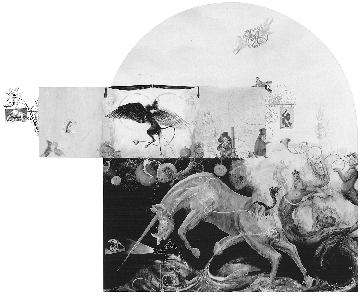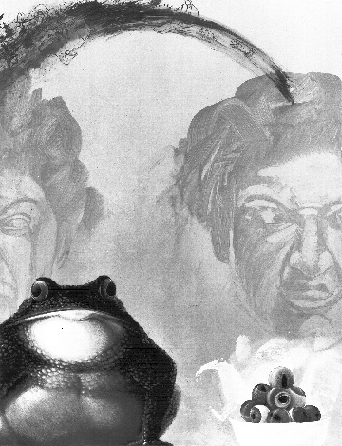
Tom Knechtel Lessons in The Theatre: Ejaculations, 1992.
Oil on panel, 41 x 50 1/2 inches.
|
As I think about myself as a painter and about my
relationship to painting and to language, I keep returning
to the tension between my public life as an artist and my
private life in the studio. Though the two things are woven
together, they're not necessarily congruent, and it seems
impossible to chart that territory—it's so elusive, so
subjective. I think of my painting as being filled with the
stuff of literature and language: metaphor, rhymes,
narrative, character. And yet, as I try to describe that
relationship directly, what is produced is a slapstick
routine: I slip and slide and fall flat on my ass. I
suspect that what is being cultivated is a protective
naiveté in order to shield what is for me, essentially, a
very private practice. Ignorance of the world can't be used
as an excuse: I went to Cal Arts in the early seventies,
teach in two of the leading art schools here in Los Angeles
and live in this city so that I can be around other artists
whose work excites me, most of which work looks nothing like
my own. If I try to step a little aside from the need to
see myself as unique, my work can be described as fitting
into an investigation of identity and sexuality which is
very prevalent in this country. I can't claim to be
crawling out of my cave in the hillside, blinking my eyes at
all this far-fetched art stuff. And yet I find myself
grappling with an extraordinary protectiveness about my life
in the studio, a protectiveness which ties up my tongue,
makes my mind go blank, makes me feel like a dope or an
innocent.

Tom Knechtel Bardo, 1995.
Oil on panel, 13 x 10 inches.
|
I think this ersatz innocence is mixed with very specific
pleasures, and perhaps those pleasures are more germane—
certainly more interesting—than my claims to naiveté. Let
me tell you about one of my favorite fantasies, so delicious
to me that it nudges up next to my erotic fantasies. I live
in a second-floor apartment, and what would be the bedroom
is the studio, with a window overlooking the entrance to the
apartment. When I'm gone, my cat sits in this window,
waiting for me, watching the sidewalk. Sometimes as I come
home I look up and fully expect to see, beside her
silhouette, a great mass of faces looking down, eyes shining
expectantly, waiting for me to get indoors, back into the
studio with them. Huge wrestlers, elephants, water buffalo,
Indian gods and dancers, commedia figures, monkeys, trained
bears, geese —everyone stampeding from the window over to
the door when they hear my key in the lock.
I often think of my painting as a kind of imaginary theatre
company. I love theatre. My tastes are very specific,
though. The theatre which draws me towards it is based on
an interaction between the desire to suspend disbelief, the
need to communicate and how temporal and impermanent that
transaction is. I'm trying to articulate what is most
private and pleasurable to me—let my try to do that instead
by offering examples of what theatre thrills me: Ariane
Mnouchkine and the Theatre du Soleil. Giorgio Strehler and
the Piccolo Teatro. Charles Ludlam and the Theatre of the
Ridiculous. Drag. Puppet theatres. Kabuki and bunraku
from Japan, kathakail from India. Circuses. Commedia
dell'arte.
Los Angeles, while rich in artists, is impoverished in this
kind of stylized theatre based on a love of the artificial
and the spectacular. The city is simply too tied to the
film and television industry, and theatre is secondary to
those industries, serving their needs with an endless stream
of showcases for actors needing employment. It's not their
fault, but I don't like going to see it. Only in the
theatres listed above does my love of allegory,
artificiality, spectacle, wonder and narrative find itself
amply gratified; and since I don't get to see them often,
that appetite goes roaring into my painting. The characters
who inhabit my paintings (the ones who are all by the window
waiting for me to finish typing this and come home to my
studio) are not symbols but a repertory company of actors
anxious to cram into the next tableau.
I mentioned narrative. That's one other element which feeds
my life in the studio. I love the kinds of stories which
spiral and meander, lost in the pleasures of narrative
invention: fairy tales, The 1001 Nights, Tristam
Shandy, nineteenth-century novels, pornographic
fantasies. I suppose that I am not nervous about my love of
literary content, the alleged bugbear of contemporary
painting, because it's balanced by the intense pleasure I
get from the physical language of paint, the visceral form
of the material even when it's not engaged in
representation. I get lost looking at paintings and
drawings, my eyes gliding through them as if through a
landscape. I get lost a lot in my studio: lost in
pleasure, in doubt, in grief and expectation, in sex and
other men's bodies, in an endless conversation with other
artists and writers, in the surprise of my brush making the
oily film do something I didn't expect, lost in the space
between the paint being something that squirted out of a
tube a minute ago and now it's a man doing his best to fit
into an opulent ball gown.
How can I convince you of the primacy of my own pleasures
and of my conviction that those pleasures are not merely
onanistic but help to articulate the world?
Tom Knechtel is a painter living in Los Angeles. His next
show will be at PPOW Gallery in New York in 1997.
|
|